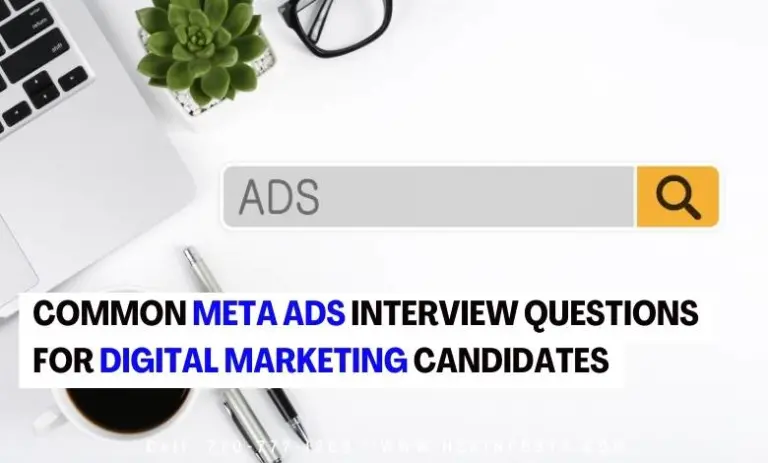As digital marketing continues to evolve, mastering platforms like Meta Ads (formerly known as Facebook Ads) has become essential for marketers. To stand out in a competitive job market, candidates need to be well-prepared for interview questions that test their knowledge, creativity, and strategic thinking. This blog post will guide you through common Meta Ads interview questions and provide tips to help you excel in your interview.
Introduction to Meta Ads
Meta Ads, a powerful advertising platform, allows businesses to reach their target audience through various ad formats and targeting options. With millions of users worldwide, it provides a vast potential for brands to increase their visibility and achieve their marketing goals. As a digital marketing candidate, demonstrating a solid understanding of Meta Ads can set you apart from other applicants.
Fundamental Questions
Q1. What are Meta Ads?
Answer: Meta Ads is an online advertising platform that enables businesses to create and run ads on social media platforms. It offers a range of ad formats, targeting options, and measurement tools to help businesses reach their desired audience and achieve specific marketing objectives.
Q2. How does the Meta Ads algorithm work?
Answer: The Meta Ads algorithm determines which ads to show to users based on various factors, including ad quality, bid amount, and user relevance. The algorithm considers user behavior, demographics, and interests to match ads with the most appropriate audience.
Q3. What are the different ad formats available on Meta Ads?
Answer: Meta Ads offers several ad formats, including image ads, video ads, carousel ads, slideshow ads, and collection ads. Each format serves different purposes, such as driving traffic, generating leads, or promoting products.
Strategic Questions
Q. 1 How do you determine the target audience for a Meta Ads campaign?
Answer: To determine the target audience, consider factors such as demographics, interests, behaviors, and location. Analyzing customer data, conducting market research, and leveraging Meta’s Audience Insights tool can help refine the target audience.
Q2.How do you set a budget for a Meta Ads campaign?
Answer: Setting a budget involves considering factors such as campaign objectives, expected ROI, and available resources. Start with a daily or lifetime budget, and use Meta’s bidding options to control costs. Monitor performance and adjust the budget as needed based on campaign results.
Q3. How do you measure the success of a Meta Ads campaign?
Answer: Success can be measured using various metrics, including impressions, clicks, click-through rate (CTR), conversions, and return on ad spend (ROAS). The specific metrics depend on the campaign’s goals, such as increasing brand awareness, generating leads, or driving sales.
Technical Questions
Q1. What is the Meta Pixel, and how is it used?
Answer: The Meta Pixel is a piece of code that tracks user interactions on a website. It helps measure ad effectiveness, track conversions, and build audiences for retargeting. To use the Meta Pixel, add the code to the website’s header and configure it to track specific events.
Q2. How do you create a lookalike audience on Meta Ads?
Answer: To create a lookalike audience, start with a source audience, such as a custom audience or website visitors. Use Meta’s lookalike audience feature to find users similar to the source audience. Define the audience size and location to reach a broader or more specific group.
Q3. What are some common issues faced during Meta Ads campaigns, and how do you resolve them?
Answer: Common issues include ad disapproval, low ad relevance scores, and high CPC. To resolve these issues, ensure ads comply with Meta’s advertising policies, optimize ad creatives and targeting, and experiment with different bidding strategies.
Creative Questions
Q1. How do you create compelling ad creatives for Meta Ads?
Answer: Compelling ad creatives capture attention and drive engagement. Focus on clear messaging, high-quality visuals, and a strong call to action (CTA). Tailor creatives to the target audience’s preferences and test different variations to find the most effective approach.
Q2. How do you use storytelling in Meta Ads?
Answer: Storytelling involves creating a narrative that resonates with the audience. Use carousel ads to tell a sequential story, or use video ads to showcase brand values and customer experiences. Storytelling can create an emotional connection and increase ad engagement.
Analytical Questions
Q1. How do you analyze the performance of Meta Ads campaigns?
Answer: Analyze performance using Meta Ads Manager, which provides detailed insights into campaign metrics. Look at key metrics such as CTR, conversion rate, and ROAS. Use A/B testing to compare different ad variations and identify areas for optimization.
Q2. How do you optimize Meta Ads campaigns for better results?
Answer: Optimization involves refining targeting, ad creatives, and bidding strategies. Use data from previous campaigns to identify trends and make data-driven decisions. Experiment with different audience segments, ad formats, and placements to find the best-performing combination.
Behavioral Questions
Q1. Describe a challenging Meta Ads campaign you’ve managed and how you overcame it.
Answer: Interviewers may ask this question to gauge your problem-solving skills and experience. Discuss a specific challenge, such as low engagement or budget constraints, and explain the steps you took to address it. Highlight the outcomes and lessons learned.
Q2. How do you stay updated with the latest trends and changes in Meta Ads?
Answer: Staying updated involves following industry blogs, attending webinars, and participating in online forums. Additionally, regularly reviewing Meta’s official updates and experimenting with new features can help you stay ahead of changes in the platform.
Practical Tips for Meta Ads Interviews
Research the Company and Industry
Understand the company’s products, services, and target audience. Familiarize yourself with the industry’s latest trends and challenges. Tailor your answers to show how your skills align with the company’s goals.
Practice Mock Interviews
Practice answering common Meta Ads interview questions with a friend or mentor. Focus on clear and concise responses that demonstrate your expertise. Use real-life examples to illustrate your experience and skills.
Showcase Your Portfolio
A strong portfolio is your best asset when interviewing for a Meta Ads-related role. It provides tangible proof of your experience and expertise in managing advertising campaigns. Here’s what to include in your portfolio:
✅ Past Campaigns & Case Studies – Bring a collection of your most successful campaigns, including the objectives, strategies used, and final outcomes. Clearly outline your role in each campaign and the specific tactics you employed.
✅ Performance Metrics & Insights – Data speaks volumes. Provide key performance indicators (KPIs) such as click-through rates (CTR), conversion rates, cost per acquisition (CPA), return on ad spend (ROAS), and audience engagement metrics. Be prepared to discuss how you analyzed these numbers to optimize performance.
✅ Challenges & Solutions – Highlight any challenges you faced while managing campaigns, such as ad fatigue, audience targeting issues, or budget constraints. Explain the strategies you implemented to overcome these obstacles and achieve better results.
✅ Creative & Copywriting Examples – If possible, showcase ad creatives, headlines, and descriptions that performed well. Explain how you A/B tested different creatives to improve engagement and conversions.
A well-structured portfolio not only demonstrates your experience but also proves that you are results-driven and capable of making data-informed decisions.
Be Prepared for Technical Questions in Meta Ads Interviews
Meta Ads is more than just launching and managing campaigns—it requires a deep understanding of the platform’s technical features and optimization strategies. Employers want to ensure that you can not only create compelling ads but also implement tracking mechanisms, optimize audience targeting, manage bidding strategies, and scale successful campaigns effectively.
In an interview, you can expect technical questions that test your knowledge of Meta Pixel, audience segmentation, ad auctions, placements, and scaling techniques. Here’s how to prepare for these topics and impress your interviewer.
🔹 Meta Pixel Implementation
Why It’s Important:
The Meta Pixel is a critical tool for tracking user interactions on a website and optimizing ad performance. Without proper implementation, advertisers lose valuable insights into user behavior, retargeting opportunities, and conversion tracking.
What You Should Be Ready to Discuss:
- What is Meta Pixel? – Explain that it’s a JavaScript code snippet that tracks website visitors’ actions and sends data back to Meta Ads Manager for optimization.
- How to Set It Up Correctly: – Walk through the steps of installing the Pixel manually or via Google Tag Manager.
- Standard vs. Custom Events: – Highlight the difference between predefined standard events (e.g., Page View, Add to Cart, Purchase) and custom conversions (e.g., tracking users who stay on a page for a certain duration).
- Troubleshooting Common Pixel Issues: – Discuss methods to diagnose tracking problems using Meta Pixel Helper, Event Manager Debugging, and testing with Facebook Test Events tool.
Example Interview Response:
“Meta Pixel is essential for tracking user interactions on a website. I typically implement it using Google Tag Manager for easier deployment and management. When setting up events, I ensure that standard events like ‘Purchase’ and ‘Add to Cart’ are firing correctly and use custom conversions for tracking unique business goals. If there’s an issue, I troubleshoot using the Meta Pixel Helper tool and Meta Events Manager to verify data accuracy and resolve missing or duplicate event issues.”
🔹 Custom & Lookalike Audiences
Why It’s Important:
One of Meta Ads’ biggest advantages is its audience targeting capabilities. Understanding how to build and optimize Custom and Lookalike Audiences allows advertisers to reach the right users efficiently and improve ROAS (Return on Ad Spend).
What You Should Be Ready to Discuss:
- How to Create Custom Audiences: – Explain how you segment audiences based on website visitors, customer lists, app activity, or engagement (video views, lead forms, etc.).
- How Lookalike Audiences Work: – Describe how Meta Ads finds new users similar to your existing customers by analyzing shared characteristics.
- Best Practices for Audience Segmentation: – Discuss the importance of excluding existing customers from acquisition campaigns, testing different audience sizes (1% to 10%), and layering Lookalikes with interest-based targeting.
Example Interview Response:
“When running retargeting campaigns, I create Custom Audiences based on high-intent users, such as those who visited the checkout page but didn’t complete the purchase. For Lookalike Audiences, I often start with a 1% Lookalike of past purchasers and gradually expand to 2%-3% for scaling. Additionally, I refine targeting by layering behavioral interests and excluding users who have already converted.”
🔹 Ad Auction & Bidding Strategies
Why It’s Important:
Meta Ads uses an auction-based system to determine which ads get shown to users. Optimizing bids correctly can reduce ad costs, improve conversions, and ensure budget efficiency.
What You Should Be Ready to Discuss:
- How the Meta Ads Auction Works: – Explain that the ad auction considers bid amount, estimated action rate, and ad quality to determine the winner.
- Bidding Strategies & When to Use Them:
- Lowest Cost (Automatic Bidding): Best for maximizing conversions within budget.
- Cost Cap: Helps control cost per result while maintaining volume.
- Bid Cap: Useful for strict cost control, but can limit delivery.
- Value-Based Bidding: Optimizes for higher-value conversions instead of quantity.
- Adjusting Bids Based on Performance: – Discuss how you monitor CPC, CPA, and ROAS and adjust bids accordingly.
Example Interview Response:
“Meta’s ad auction considers bid value, estimated action rate, and ad quality to determine placement. When running lead generation campaigns, I prefer using Cost Cap bidding to ensure I maintain a profitable CPA while scaling. However, for high-ticket items, I use Value-Based Bidding to prioritize users who are likely to generate higher revenue rather than just drive low-cost leads.”
🔹 Ad Placements & Formats
Why It’s Important:
Choosing the right ad placement and format can increase engagement and maximize ROI. Meta offers multiple ad placements, each serving different campaign goals.
What You Should Be Ready to Discuss:
- Ad Placement Options: Feed Ads, Stories, Reels, In-Stream Videos, Search, Audience Network, Messenger, etc.
- When to Use Specific Placements:
- Stories & Reels: Best for engagement and brand awareness.
- Feed Ads: Effective for direct response campaigns.
- Messenger Ads: Useful for driving conversations & lead generation.
- Ad Format Selection: Image Ads, Carousel Ads, Video Ads, Collection Ads, etc.
Example Interview Response:
“For e-commerce campaigns, I prioritize placements that align with user behavior. For example, I use dynamic product ads in Facebook and Instagram Feeds for high-intent users while leveraging Stories for brand awareness. In conversion-focused campaigns, I often test multiple placements but optimize delivery towards the highest-performing ones.”
🔹 Optimization & Scaling Strategies
Why It’s Important:
Scaling campaigns effectively while maintaining performance is a key skill for Meta Ads specialists.
What You Should Be Ready to Discuss:
- How to Optimize Underperforming Campaigns:
- Refining audience targeting (exclude irrelevant users, adjust Lookalikes).
- A/B testing creatives and ad copies to improve engagement.
- Adjusting bidding strategy based on cost efficiency.
- How to Scale Successful Campaigns:
- Horizontal scaling: Expanding into new audiences.
- Vertical scaling: Increasing budget gradually while monitoring CPA.
- Creative refresh strategies to avoid ad fatigue.
Example Interview Response:
“When scaling a successful campaign, I start by increasing the budget gradually (20-30% every 48 hours) to avoid disrupting the learning phase. If performance drops, I analyze frequency and creative fatigue, then introduce new variations of top-performing ads. For horizontal scaling, I expand Lookalike Audiences beyond the initial 1% to 3%-5% to reach a broader but still relevant audience.”
Demonstrate Your Analytical Skills in Meta Ads Success
Meta Ads success is deeply rooted in data analysis and continuous optimization. To maximize campaign effectiveness, advertisers must not only track performance metrics but also interpret data insights and take strategic actions.
During an interview for a Meta Ads-related role, hiring managers will want to assess your analytical skills and decision-making process. They’ll look for candidates who can demonstrate a strong grasp of data-driven strategies, experience with analytics tools, optimization techniques, and the ability to identify market trends.
Here’s how you can effectively showcase your analytical mindset and prove that you’re more than just an ad manager, you’re a results-driven strategist.
📊 Data-Driven Decision Making
Why it Matters:
Meta Ads thrive on measurable outcomes. Employers want to see that you can analyze key performance indicators (KPIs) to make informed decisions rather than relying on assumptions.
How to Showcase This Skill:
- Explain how you track campaign success using key metrics such as CTR (Click-Through Rate), CPC (Cost Per Click), CPA (Cost Per Acquisition), Conversion Rate, and ROAS (Return on Ad Spend).
- Demonstrate how you interpret data and make adjustments based on performance. For example, if an ad has a high CTR but a low conversion rate, you might refine the landing page experience or adjust audience targeting.
- Provide a real-world example of how data-driven decisions impacted performance.
Example Response:
“In my previous role, I ran a Meta Ads campaign for an e-commerce brand. Initially, the campaign had a high CTR of 4.5%, but conversions were low. By analyzing the funnel, I discovered that the product page had a high bounce rate. I collaborated with the UX team to optimize the page layout and streamline the checkout process. As a result, the conversion rate improved by 30%, reducing the CPA by 25%.”
📈 Experience with Analytics Tools
Why it Matters:
Meta Ads success depends on accurate tracking and reporting, so familiarity with industry-standard analytics tools is crucial.
How to Showcase This Skill:
- Highlight your proficiency with Meta Ads Manager, Google Analytics, and third-party tracking tools like HubSpot, Adobe Analytics, or Facebook Pixel.
- Explain how you integrate multiple data sources to get a comprehensive view of campaign performance.
- Discuss how you set up event tracking, conversion goals, and audience segmentation to measure performance more accurately.
Example Response:
“I am highly proficient in Meta Ads Manager and Google Analytics. In a previous campaign, I combined Meta’s Audience Insights with Google Analytics user behavior reports to refine audience segmentation. I noticed that mobile users had higher engagement but lower conversion rates, so I adjusted the ad creatives for a more mobile-friendly experience. This led to a 20% increase in mobile conversions.”
🎯 Optimization Techniques
Why it Matters:
Successful Meta Ads campaigns require ongoing testing and optimization. Recruiters will want to see that you know how to analyze performance trends and implement changes that drive better results.
How to Showcase This Skill:
- Talk about specific A/B testing strategies you’ve used to compare ad creatives, headlines, or call-to-action (CTA) buttons.
- Explain how you optimize audience targeting by refining lookalike audiences, retargeting engaged users, or excluding low-performing demographics.
- Demonstrate how you improved KPIs such as reducing cost per conversion, increasing engagement rates, or boosting ROAS (Return on Ad Spend).
Example Response:
“I once ran an ad campaign for a SaaS product where the CPA was too high. I conducted an A/B test comparing a broad audience vs. a refined custom audience of past website visitors. The refined audience had a 40% lower CPA, so I scaled the campaign accordingly. Additionally, I tested different ad creatives and found that short, benefits-driven copy outperformed feature-heavy descriptions, further improving conversion rates.”
🔍 Identifying Trends & Opportunities
Why it Matters:
A great Meta Ads strategist doesn’t just react to data—they anticipate trends and identify opportunities for growth.
How to Showcase This Skill:
- Demonstrate how you spot patterns in consumer behavior and make data-backed predictions.
- Explain how you use seasonality trends or competitor analysis to refine your strategy.
- Showcase an example of how you adapted a campaign strategy to take advantage of an emerging trend or market shift.
Example Response:
“During a Black Friday campaign, I noticed that engagement rates started rising a week earlier than expected. Instead of waiting for the official promotion date, I launched teaser ads and early access discounts to capitalize on the momentum. This led to a 35% increase in sales compared to the previous year.”
Strong analytical skills demonstrate that you are not just running ads but continuously improving them based on real data.
Conclusion
Preparing for a Meta Ads interview requires a thorough understanding of the platform’s features, strategies, and best practices. By familiarizing yourself with common interview questions for digital marketing and practicing your responses, you can confidently showcase your expertise and stand out as a top candidate. Remember to stay updated with the latest trends and continuously improve your skills to succeed in the ever-evolving field of digital marketing.



























3 Responses
Hello